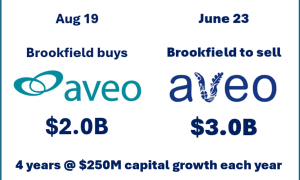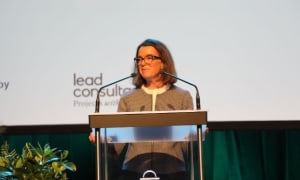As we prepared to go to press this morning, the UTS Ageing Research Collaborative (UARC) released its Australia's Aged Care Sector: Mid-Year Report 2023-24, for the six months to 31 December 2023, highlighting the capital financing challenges facing the sector and providers' use of funding intended for care on accommodation and everyday living services.
Capital finance challenges
With estimates the capital investment required for new builds and refurbishments are as high as $72 billion, the report states the sector’s returns are trending downward and are uncompetitive compared to alternative investment opportunities, such as publicly listed healthcare providers - see chart above.
Policy uncertainty and the sector’s poor financial performance will continue to make raising sufficient capital challenging.
"Hopefully, the Government’s upcoming response to the Taskforce’s recommendations will address some of these fundamental issues to ensure the sector’s long-term sustainability," the report states.
"Problematic cross-subsidisation pattern"
Taxpayers are funding aged care to a greater degree than ever before, with Government funding up 64% from 2019-29 to $32.3 billion in 2023-24, and overall financial results are improving.
In the first half of 2023–24, the financial results of residential aged care homes improved on average with the loss per resident per day shrinking to $4.02 compared to $17.47 for the same period in 2022-23.
Yet, half of all homes are still recording a loss.
"The Aged Care Taskforce made some sensible recommendations to reform aged care funding, including that direct care services should remain primarily a government responsibility, but higher co-contributions should be required for everyday living services and accommodation from individuals who have the financial means to do so.
"We hope this will be the centrepiece of a multipartisan agreement among our parliamentarians."
The report also notes that "many homes are generating margins from publicly funded direct care services to cross-subsidise their losses from delivering everyday living services and accommodation services."
The UARC research reveals that the "primary reason" for the improved financial performance is a "significant underspend" on direct care staff by a portion of the 63.9% of homes that did not meet their mandatory care minute targets.
UARC research shows that homes still below their care minute targets are earning substantial direct care margins (averaging $17.44 per resident per day) while homes meeting or exceeding their targets are much closer to funding parity (averaging $1.66 per resident per day).
The trend also reflects star ratings, with 4 and 5 Star homes generating significant deficits.
The report also notes the importance of how the new Aged Care Act will intersect with Retirement Village legislation and its definitions of where residential care can be provided.
You can read the report here.
We will explore the report in further detail in the weeks ahead.










